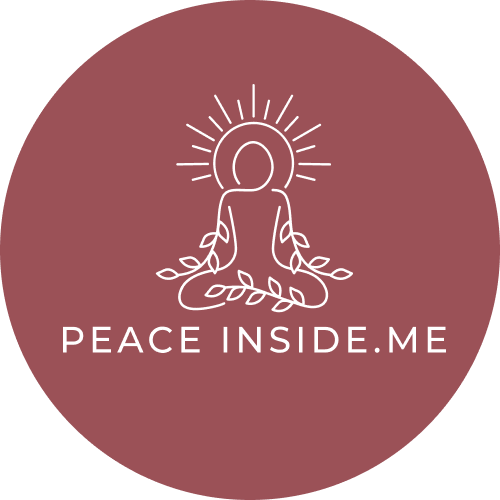peaceinside.me
Restorative Yoga: A Gentle Practice for Stress and Burnout Recovery
Please note, this post is partially or fully sponsored and may contain affiliate links.
In a world that often celebrates hustle, speed, and productivity, slowing down can feel unfamiliar—even uncomfortable. But when stress builds up and burnout sets in, what we often need most is stillness, softness, and time to truly rest.
Restorative yoga offers exactly that.
Unlike more active forms of yoga, restorative yoga is a deeply relaxing, meditative practice that encourages the body and nervous system to reset. It's especially helpful for people experiencing chronic stress, anxiety, emotional exhaustion, or burnout. Through long-held supported poses and intentional breathing, restorative yoga helps bring us back to a place of balance—one breath at a time.
Restorative yoga offers exactly that.
Unlike more active forms of yoga, restorative yoga is a deeply relaxing, meditative practice that encourages the body and nervous system to reset. It's especially helpful for people experiencing chronic stress, anxiety, emotional exhaustion, or burnout. Through long-held supported poses and intentional breathing, restorative yoga helps bring us back to a place of balance—one breath at a time.

What is Restorative Yoga?
Restorative yoga is a gentle, therapeutic style of yoga that uses props like bolsters, blankets, blocks, and straps to fully support the body in restful poses. Each pose is held for 5 to 20 minutes, allowing the body to relax completely without effort or strain.
There is no stretching, strengthening, or sweating—just surrendering to stillness.
The purpose is to activate the parasympathetic nervous system (the “rest and digest” mode), which helps reduce stress, lower cortisol levels, and create conditions for physical, emotional, and mental recovery.
The Impact of Chronic Stress and Burnout
When we experience stress, our bodies naturally enter fight-or-flight mode, releasing hormones like cortisol and adrenaline. This response is helpful in emergencies, but when stress becomes chronic—as it often does in today’s fast-paced world—our bodies stay stuck in survival mode.
Symptoms of chronic stress and burnout may include:
- Fatigue or insomnia
- Brain fog and forgetfulness
- Anxiety or irritability
- Muscle tension and headaches
- Disconnection or emotional numbness
A 2021 study published in Frontiers in Psychology found that burnout significantly affects emotional regulation, sleep quality, and physical health—especially in helping professionals, caregivers, and overworked employees (Moss et al., 2021).
Restorative yoga helps reverse the stress response by offering space to rest deeply and recover fully.
Restorative yoga is a gentle, therapeutic style of yoga that uses props like bolsters, blankets, blocks, and straps to fully support the body in restful poses. Each pose is held for 5 to 20 minutes, allowing the body to relax completely without effort or strain.
There is no stretching, strengthening, or sweating—just surrendering to stillness.
The purpose is to activate the parasympathetic nervous system (the “rest and digest” mode), which helps reduce stress, lower cortisol levels, and create conditions for physical, emotional, and mental recovery.
The Impact of Chronic Stress and Burnout
When we experience stress, our bodies naturally enter fight-or-flight mode, releasing hormones like cortisol and adrenaline. This response is helpful in emergencies, but when stress becomes chronic—as it often does in today’s fast-paced world—our bodies stay stuck in survival mode.
Symptoms of chronic stress and burnout may include:
- Fatigue or insomnia
- Brain fog and forgetfulness
- Anxiety or irritability
- Muscle tension and headaches
- Disconnection or emotional numbness
A 2021 study published in Frontiers in Psychology found that burnout significantly affects emotional regulation, sleep quality, and physical health—especially in helping professionals, caregivers, and overworked employees (Moss et al., 2021).
Restorative yoga helps reverse the stress response by offering space to rest deeply and recover fully.

How Restorative Yoga Supports Stress and Burnout Recovery
🧘 1. Calms the Nervous System
By supporting the body in restful postures, restorative yoga allows the nervous system to shift out of fight-or-flight and into the parasympathetic state. This is where digestion, healing, and immune function improve.
A 2014 study in the Journal of Alternative and Complementary Medicine showed that restorative yoga significantly reduced stress and anxiety levels, especially in women experiencing burnout or fatigue (Park et al., 2014).
🌿 2. Encourages Deep Rest
Unlike sleep, where the body may still hold tension, restorative yoga encourages conscious rest—a state of wakeful relaxation where the body can truly release and reset.
This kind of rest helps:
- Restore adrenal health
- Reduce muscle tension
- Improve sleep quality
- Support emotional balance
🧠 3. Improves Emotional Awareness
Restorative yoga creates a safe space to turn inward. With no need to perform or achieve, the practice invites self-inquiry and emotional awareness.
As the body softens, long-held emotions may rise to the surface, offering a chance to process feelings gently and without judgment. This emotional release is an essential part of burnout recovery.
💓 4. Builds Resilience and Self-Compassion
Practicing stillness in restorative yoga can feel unfamiliar—especially for those used to being busy. But over time, it cultivates patience, presence, and self-compassion, helping individuals become more resilient to stress in the long run.
Rest becomes a choice, not a last resort.
🧘 1. Calms the Nervous System
By supporting the body in restful postures, restorative yoga allows the nervous system to shift out of fight-or-flight and into the parasympathetic state. This is where digestion, healing, and immune function improve.
A 2014 study in the Journal of Alternative and Complementary Medicine showed that restorative yoga significantly reduced stress and anxiety levels, especially in women experiencing burnout or fatigue (Park et al., 2014).
🌿 2. Encourages Deep Rest
Unlike sleep, where the body may still hold tension, restorative yoga encourages conscious rest—a state of wakeful relaxation where the body can truly release and reset.
This kind of rest helps:
- Restore adrenal health
- Reduce muscle tension
- Improve sleep quality
- Support emotional balance
🧠 3. Improves Emotional Awareness
Restorative yoga creates a safe space to turn inward. With no need to perform or achieve, the practice invites self-inquiry and emotional awareness.
As the body softens, long-held emotions may rise to the surface, offering a chance to process feelings gently and without judgment. This emotional release is an essential part of burnout recovery.
💓 4. Builds Resilience and Self-Compassion
Practicing stillness in restorative yoga can feel unfamiliar—especially for those used to being busy. But over time, it cultivates patience, presence, and self-compassion, helping individuals become more resilient to stress in the long run.
Rest becomes a choice, not a last resort.

What to Expect in a Restorative Yoga Session
In a typical class, you may do 4 to 6 poses over the course of 60–90 minutes. Some common postures include:
- Supported Child’s Pose (Balasana): Releases tension in the lower back and hips
- Reclining Bound Angle (Supta Baddha Konasana): Opens the heart and calms the mind
- Legs-Up-the-Wall (Viparita Karani): Reduces fatigue and improves circulation
- Supported Savasana: A fully rested position for deep integration and relaxation
Breathwork, calming music, and gentle guided meditation may be included to enhance the experience.
Each pose is supported with props so that the body feels fully held, allowing the muscles to release and the mind to quiet.
Tips for Starting Your Own Restorative Practice
Whether you join a class or practice at home, here are a few tips:
- Create a quiet space: Use blankets, cushions, or pillows for support
- Use a timer: Hold each pose for at least 5–10 minutes
- Breathe deeply: Inhale slowly through the nose and exhale through the mouth
- Stay warm: Cover yourself with a blanket to encourage relaxation
- Let go of effort: The goal is not to stretch or do—it’s simply to be
Even 20 minutes a day of restorative yoga can make a difference.
In a typical class, you may do 4 to 6 poses over the course of 60–90 minutes. Some common postures include:
- Supported Child’s Pose (Balasana): Releases tension in the lower back and hips
- Reclining Bound Angle (Supta Baddha Konasana): Opens the heart and calms the mind
- Legs-Up-the-Wall (Viparita Karani): Reduces fatigue and improves circulation
- Supported Savasana: A fully rested position for deep integration and relaxation
Breathwork, calming music, and gentle guided meditation may be included to enhance the experience.
Each pose is supported with props so that the body feels fully held, allowing the muscles to release and the mind to quiet.
Tips for Starting Your Own Restorative Practice
Whether you join a class or practice at home, here are a few tips:
- Create a quiet space: Use blankets, cushions, or pillows for support
- Use a timer: Hold each pose for at least 5–10 minutes
- Breathe deeply: Inhale slowly through the nose and exhale through the mouth
- Stay warm: Cover yourself with a blanket to encourage relaxation
- Let go of effort: The goal is not to stretch or do—it’s simply to be
Even 20 minutes a day of restorative yoga can make a difference.

Who Can Benefit from Restorative Yoga?
Restorative yoga is especially supportive for:
- People with high stress or burnout
- Individuals recovering from illness, injury, or surgery
- Those with anxiety, depression, or insomnia
- Caregivers, healthcare workers, and parents
- Anyone feeling emotionally or physically depleted
Because it’s gentle and adaptable, restorative yoga is accessible for all ages and abilities.
Restorative yoga is especially supportive for:
- People with high stress or burnout
- Individuals recovering from illness, injury, or surgery
- Those with anxiety, depression, or insomnia
- Caregivers, healthcare workers, and parents
- Anyone feeling emotionally or physically depleted
Because it’s gentle and adaptable, restorative yoga is accessible for all ages and abilities.
Final Thoughts
In a culture that often rewards doing more, restorative yoga gently asks us to do less. It invites us to slow down, tune in, and let go. It creates a safe, nurturing space where stress softens, burnout begins to heal, and the body remembers how to rest. If you’re feeling exhausted, overwhelmed, or disconnected, restorative yoga might be the soft landing you need—a quiet return to yourself. Because sometimes, the most powerful healing happens when we pause and simply allow ourselves to rest.
Sources
1. Moss, J. D., et al. (2021). Burnout, fatigue, and mental health challenges among healthcare professionals. Frontiers in Psychology, 12, 669456.
2. Park, C. L., et al. (2014). Effects of yoga on stress and mood in women with emotional exhaustion. Journal of Alternative and Complementary Medicine, 20(2), 114–123.
In a culture that often rewards doing more, restorative yoga gently asks us to do less. It invites us to slow down, tune in, and let go. It creates a safe, nurturing space where stress softens, burnout begins to heal, and the body remembers how to rest. If you’re feeling exhausted, overwhelmed, or disconnected, restorative yoga might be the soft landing you need—a quiet return to yourself. Because sometimes, the most powerful healing happens when we pause and simply allow ourselves to rest.
Sources
1. Moss, J. D., et al. (2021). Burnout, fatigue, and mental health challenges among healthcare professionals. Frontiers in Psychology, 12, 669456.
2. Park, C. L., et al. (2014). Effects of yoga on stress and mood in women with emotional exhaustion. Journal of Alternative and Complementary Medicine, 20(2), 114–123.
~
See a typo or inaccuracy? Let us know so we can fix it!
Sharing is caring ❤️
~
~
~
BECOME A PEACE INSIDER
Sign up for peaceinside.me information, inspiration, and specials.



